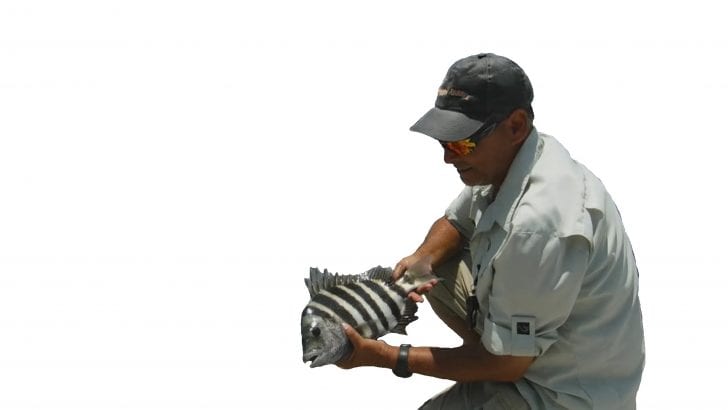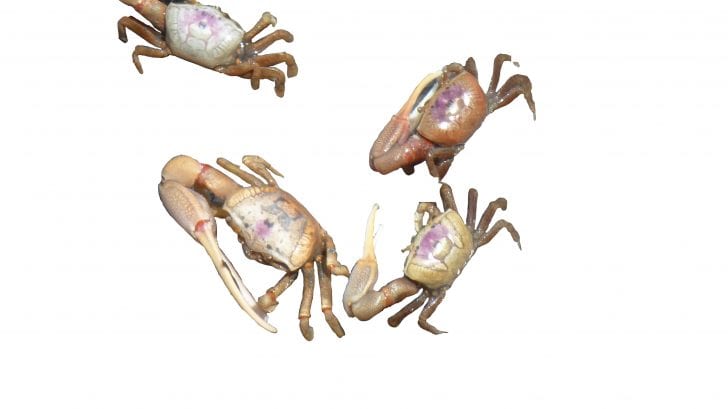Is there a difference between Summer Sheepshead and Winter Sheepshead? The answer is no. It is still the same fish.
Are Sheepshead larger in the Winter than in the Summer? The answer is no. The larger Sheepshead are just easier to catch in the Winter because of the lack of competition for food due to a number of other species of fish moving out to sea during the colder months.
The main difference between Summer Sheepshead and Winter Sheepshead is their feeding habits.
During the Winter, you can target Sheepshead with ease using fresh Clam out of the shell, Oysters, Barnacles and Mussels, usually without the threat of any other species removing it from your hook before the Sheepshead ever know it’s there.
As for the Summer months, trying to use fresh Clam out of the shell is like ringing the dinner bell for every Pinfish, Black Sea Bass, Pufferfish, Spot and Croaker in the area.
When using fresh Clam or Oyster out of the shell, you will most likely hook one of them before a Sheepshead. So, what should you know before trying to target Sheepshead in the Summer?
The first thing we need to look at is their feeding habits in the Winter verses the Summer. A Sheepshead diet—Mussels, Barnacles, Oysters, live Shrimp and Crabs because Sheepshead primary feed on crustaceans.
During the Winter in the Lowcountry, Fiddler Crabs, along with other species of Crabs, partially hibernate during the cold months, only coming out of the mud when an abnormal sunny day warms up the mud and sand just enough for them to become active.
Our local Sheepshead are quite aware of this. They will primarily be feeding on Oysters, Barnacles and Mussels in deeper water and targeting a number of pilings, jetties and structures, which usually hold a number of these crustaceans for them.
In the Summer, Sheepshead will change their feeding tactics. A large number of them in the Lowcountry will start to follow a high tide into the flats and into the grass looking for one of their favorite Summer foods—China-back Fiddler Crabs, along with Mud Crabs.
You will be able to observe large fish roaming the flats searching debris, scuffing through sea lettuce and kicking up mud in their attempt to locate and devour as many as these Crabs as they can find. As the tide recedes, the Sheepshead will follow and finish feeding in deeper water until the next high tide.
So, targeting Sheepshead with Fiddler Crabs becomes the bait of choice through the Summer months.
You will notice that it is easier to spot Sheepshead in the shallow water as they are feeding. Just remember that a Sheepshead can spot you just as easy as you spotted him, so try to be careful, make sure to move softly, try to make yourself as unnoticeable as possible.
This will aid in keeping the fish in his feeding zone. Light Carolina rigs, using about ½ ounce to ¾ ounce egg weights, around 12 to 18 inches of 20-pound test fluorocarbon leader with a No. 2 or No. 4 Octopus hook should do the trick when using Fiddler Crabs.
The best way to hook a Fiddler Crab is to puncture the hook through the side between two legs and exit the hook out of the center of the Crab’s chest.
This will allow the Crab to stay alive and walk around. The very small hook blends itself nicely with the Crab, making it unnoticeable, and in most cases, mimics one of its legs.
When casting to a Sheepshead using the Carolina rig while sight fishing, remember not to throw directly at the fish. The Sheepshead will get spooked immediately as the weight splashes and enters the water, causing the fish to leave.
Cast softly ahead of the fish at least 4 to 5 feet away, immediately slowly reeling in or raising your rod to bring the rig and the Crab toward the Sheepshead with ease, mimicking the natural flow or drift in the water. This will not spook the Sheepshead.
The Sheepshead will become enticed, and you will find that you will be able to watch the Sheepshead slowly approach the Crab and go into his feeding mode. As he takes one, two or three pecks at the Crab, the rest is on you because this is when the timing of setting your hook comes into play, and if you manage a successful hook set, fighting the Sheepshead will be your next endeavor and the fun begins!
So, just remember, Summer Sheepshead give you the opportunity to sight fish Sheepshead in shallow water and near the grass lines. Sheepshead of all sizes, including large Sheepshead, you will be able to primarily target them with Fiddler Crabs.
For the Sheepshead lovers out there and the beginners who would like to take this species of game fish on, I hope my Summer Sheepshead tips help you land the fish of your dreams this Summer.
Until next time, and like I always say, good luck out there and have fun fishing! To view some fishing adventures, go to my “Fishing with Jiggin Jerry” Channel on YouTube or go to ww.jigginjerry.net.
To view some fishing adventures, go to my “Fishing with Jiggin Jerry” Channel on YouTube or go to www.jigginjerry.net.
You may also enjoy reading The Destruction of the Mt. Pleasant Pier




